Wisteria, Wistaria
There is a duality to Wisteria, starting with those who think it’s an invasive weed and those who like to eat its sweet, fragrant blossoms.
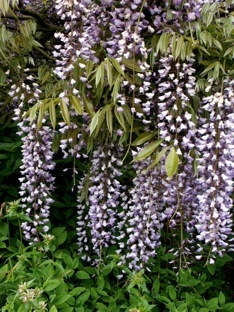
Wisteria floribunda (Japanese)
That dual nature is in keeping with the Wisteria which can also be spelled Wistaria. And how the genus got its name has two stories: Some say it is named after Dr. Caspar Wistar (1761-1818) physician, anatomist, vaccination champion and abolitionist. Others say it was named for Charles Jones Wister Sr., whose father, Daniel, paid for the voyage of the Empress of China which brought a Wisteria vine to North America from China. A former privateer built in 1783, the Empress of China was the first ship to sail to China from the newly independent United States. It also carried the first U.S. representative to China. Round voyage took 14 months. What they didn’t know was Wisteria was already here.
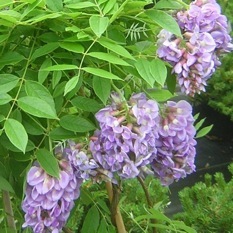
Wisteria frutescens (American)
Wiseria’s multiple personality continues with edibility. The blossoms of the plant are edible raw or cooked. The rest of the plant is toxic per se. In fact, as little as two raw seeds can kill a child. That is not uncommon for a member of the pea family which ranges from edible to toxic.
One of the most common of the 8 to 10 species of wisteria is Wisteria sinsensis, or the Chinese Wisteria, the one that hitched a ride on the Empress of China. It’s a vigorous, fast grower that doesn’t need fertilizer and fixes its own nitrogen. In fact, abuse improves blossoming as does pruning. It can live at least 144 years (as of 2014) and is consider an invasive species is some areas. It has naturalized from Maine to Florida and as far west as Arkansas. Not bad since its arrival in 1816.
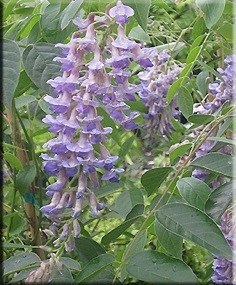
Wisteria macrostachya (Kentucky)
And while the Wisteria might have been named for the underwriter of the ship that brought it back from China there is a native Wisteria in North America, Wiseria frutescens. It has the smallest blossoms of the Wisteria clan. W. frutescens, the American Wisteria, has flowers that are not scented, and its seed pods are smooth not velvety. It is found Virginia to Louisiana down to Florida. If you find smooth seed pods but lightly scented flowers you have the W. macostachya, or the Kentucky Wisteria, also a native (found in Louisiana, Texas, Kentucky, Illinois, Missouri and Oklahoma.) To complicate things there is also Wisteria floribunda, from Japan. It is an escapee in the southern United States.
Now some qualifiers: In Japan young leaves of the W. floribunda (aka W. macrobotrys and W. multijuga)) are cooked and eaten, blossoms are blanched. The seeds are roasted. I have not tried that so I don’t recommend it. This holds true for the Wisteria venusta, or Silky Wisteria. It has white flower clusters six inches long, vine to 25 feet, 9 to 13 leaflets, counter clockwise twist. Its young leaves and young seeds reportedly cooked. Blossom have yellow blotch, AKA Wisteria brachybotrys. The seeds and leaves of the Wisteria japonica were used as a famine food — not recommended — and the flowers of the Wisteria villosa have been eaten.
As mentioned we almost know who Wisteria was named after. It is said Wiss-STEER-ree-ah. And while this is not too relevant it comes from the German/Old English word Wistar which means “steward of the food supply.” Frutescens (froo-TESS-ens) means shrubby or bushy, Floribunda (flor-ih-BUN-duh) means free flowering, many flowers, and macrostachya (mak-ro-STAY-kee uh, or mak-ro-STAK, yuh) means large (flower) spike. Venusta (ven-NUSS-tus means beautiful, charming. Wisteria is considered a pest because it will climb on virtually anything in its path. When this includes other vegetation it also spells their demise. Some can grow to 100 feet long and 15 inches through.
Green Deane’s “Itemized” Plant Profile
IDENTIFICATION: A leaf-losing perennial with pinnately compound leaves to 20 inches with 9 to 19 leaflets depending on species. Chinese Wisteria (W. sinsensis) has gray bark, velvety seed pods, jasimin-like fragrant flowers, twists counter-clockwise, 9 to 13 leaflets usually 11, vine can grow to 100 feet or more. flowering spikes to 12 inches.
American wisteria (frutescens) has smooth seed pods, small flowers have no fragrance, clockwise twist, 9 to 15 leaflets, vine 20 to 30 feet, occasionally longer in old specimens, long-lasting flower spike five to six inches.
Japanese Wisteria (W. floribunda) has white stems, velvety seed pods, fragrant flowers, twists clockwise, up to 19 leaflets, vine grows to 30 feet, flowering spikes to three feet.
Kentucky Wisteria (W. macrostachys) has smooth or slightly velvety seed pods, small flowers, slightly lilac scented to no scent, counter clock twist (though I think that is a observational mistake) flower spikes to a foot, 9 to 15 leaflets, vine length 20 to 30 feet. The Kentucky Wisterias was once considered a variation of the American Wisteria. It blooms at a younger age than W. frutescens.
ENVIRONMENT: Full sun and well-drained soil, natives can tolerate some moisture and are found in coastal plains and along streams.
TIME OF YEAR: Depends on species and location, mid-spring spring to early summer
METHOD OF PREPARATION: Blossoms raw or cooked, REMOVE THE STEMS!. The Japanese blanch their blossoms. Japanese Wisteria leaves boiled when young, seeds roasted, reportedly a chestnut flavor, leave also used for tea. None recommended regarding the Japanese Wisteria. Also raw seeds are toxic. The toxin is a glycoside which is usually a sugar molecule attached to a nitrogen molecule or the like and is stripped off during digestion.


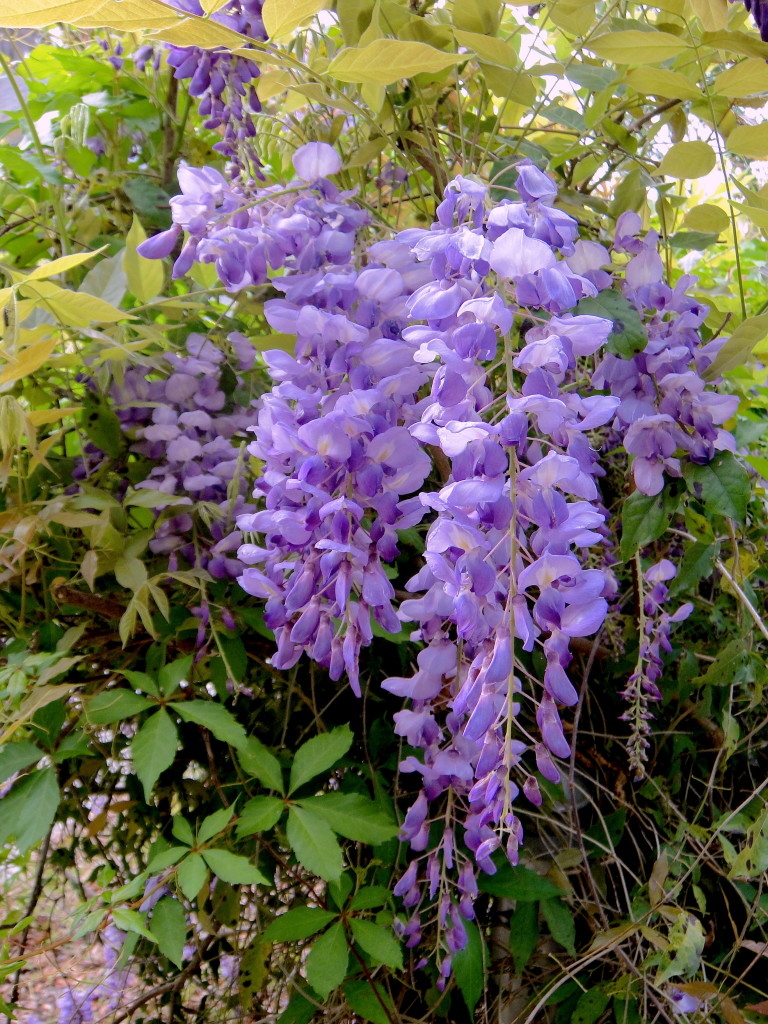
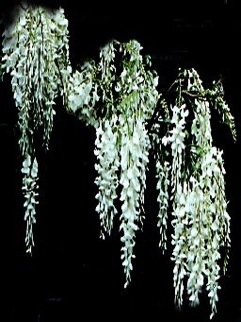



I love this site! Even though I live in Australia, I can use some of the information here, since we do have some plants/weeds in common.
Thank you for putting this information here.
I’m especially enjoying the “edible flowers” series. I would certainly have tried chicory and queen anne’s lace when I lived in the US if I’d only have known they were safe. They were everywhere around my childhood home.
Thanks for writing. Because of early sailors we have a lot of weeds in common. I’ve actually written 20 articles on edible flowers, and have 10 of them uploaded as of today.
Thanks for the info. My yard is full of wisteria. Up till now the only use I found for them was in making ties for bamboo supports for peas and other climbers. I also use the young vines to tie back limbs of trees I want to re-shape a little. They eventually rot and the limbs stay in the desired form. Now I know the flowers have a use also. I have enjoyed your posts for a while. I hope I get a chance to come to one of your classes in the future. Blessings.
Are the tubers edible?
No, the tubers are NOT edible. If they were I would have included them.
Thomas Nuttall was the first to name the genus and he clearly stated that he was naming it for Caspar Wistar. The only species he named was W. speciosa, which had previously been named Glycine frutescens; thus, Wisteria frutescens.
Thank you for posting this information. Until now, I had thought the entire plant toxic. I grew up in Oakland, Ca., and my grandmother had beautiful wisteria in the front yard. It always brings good feelings and memories when I see or smell it (must’ve been the Chinese variety. It was very fragrant).
I’m so glad I’ve found this cite! I found a pod that started to twist and brought it back home with me, ever since then I have been collecting good specimens for an art project (I have yet to decide what I’ll use them for: windchimes maybe) I found the source around the corner and though I haven’t seen it flower I think it’s the kentucky variety for it’s slightly velvety and the pods all have a counter-clockwise twist but really it depends on how you hold it. It was driving me nuts trying to figure out what that plant was, a heated debate between a friend, her I-phone, and I.
Why is it that the Poison Control and so many toxicology books report that all parts of the wisteria plant is poisonous, including the flowers… but yet there is so much written about them being edible? Also is it the Japanese wisteria leaves you do not recommend or also their flowers ? Because I find the Japanese flowers to be far superior in fragrance and sweetness
Interesting. I was telling my sister how much I love to eat wisteria blossoms and she sent me an article saying they were toxic. So I googled it and found your site.
Anyway, I reallllllly love to eat the blossoms and this is a great year for them here in Sonoma County, California where I live and since they’re growing wild even around some deserted homes, I pull over and plunder four or five stem fulls and munch them all the way down the road. Yum–taste like sweet English peas. And sometimes I let them dry on my dashboard and they’re tasty that way, too.
But everyone seems to have consensus that the seeds are toxic so I’m not going to try those. Check my Rachel Carson show out on Youtube.
How do you preserve wisteria blooms for the winter?
Drying is the usual way.
Hello,
I was wondering if all Wisteia species you listed have edible flowers? I’m not certain of the species I found and would like to make some jelly from the flowers.
I do not list non-edible flowers, or if I do I say so. But it just the blossom, other parts are not edible.
Hi there… when you say remove STEMS, do you mean th green stems? All the flowers that come off the *stem* or last green branch have a 1-2cm wee stem thats the colour and taste of the flower. too remove them all would be a nightmare, I just ran my hand down the *green* stem and they all come right off.
Is that ok?
x
Im drying them and using for tea 🙂
wondered if there were any natural remedies its used for
🙂
Id love an answer for above if possible <3 Im drying them as of now…
I would also like to know this: can I just strip the flowers off the central stem of the cluster, or do I need to remove each little ‘stemlet’ that connects each blossom to the central stem of the cluster before eating?
Does anyone know if the dried or fresh bark is toxic? like if prolonged contact with the skin will result in a toxic reaction of any kind?
Does touching the plant pose any threat?
I did cut off two large branches (maybe 5cm diameter) of a wisteria yesterday, without wearing gloves. And today I am very sleepy and have a headache. Not sure if related, but might be. My hands look fine. According to a few German sources, the bark is toxic, without providing details.
All wisteria species contain a chemical called Canavanine which interferes with l-arginine synthesis and thus results in creation of unpredictable arginine-like proteins when ingested. I wouldn’t eat any parts of any wisteria plant species, especially the seeds.
General contact with this plant during pruning isn’t known to cause toxic symptoms, however this doesn’t rule out the possibility of allergic reaction. It can also be noted that seed pods with hairs are notorious for causing itching, even in non sensitized ( non allergic ) individuals.
L.Canavanine is found in several species of legumes we eat including Alfalfa sprouts. I would not be surprised for some to be found in Black Medic seeds. Two things to consider are amount eaten and also any genetic weakness towards lupus in the family. If Lupus ran in my family I would not consume it or alfalfa sprouts. I suspect, like Fiddleheads, as a short-term seasonal edible there isn’t much of a problem for most people. But like fiddleheads I would not preserve them and eat them all year.
I have a wisteria plant growing over an iron arch in my garden. I have bird feeders hanging from the arch. I pruned the plant and brought a rather large branch of flowers inside and put in a vase. During the hours following, I felt very tired and a bit nauseated. I became so sleepy, I went for a nap. I rose more tired than before. I found that the odor of the flowers was not good, so I threw the branch outside. Within ten minutes I felt better and have gone on to be myself. Only then did I realize that it was the wisteria which had caused my fatigue. Has anyone else suffered this effect?
Hi! I have Chinese Wisteria and I want to make it into a tea. Can I use the leaves of this plant as well as the blossoms?
Would need to know the botanical name.
Is the Chinese Wisteria, Wisteria Sinensis edible in any part? i.e. flowers plucked of the stem.
Also, if I were to graft other legumes onto a wisteria trunk, would the grafted legumes become toxic? What about normally non-toxic wisteria?
I’m kinda confused about this plant. I saw many famous brand use this scent of flower to make perfume. Will it be alright for consumer to daily use it? Because it seems to be poisonous flower.
Thanks so much!
Hi Green Deane
We have a Wisteria Sinensis and were thinking of putting all the fallen leaves on our vegie garden to rot down and nourish the soil. However would you advise against this, if the leaves are toxic?
Thanks 🙂
If I understand it correctly, the toxicity happens when we consume it; and it wouldn’t have any bad effect what so ever on the soil. In fact, being in the pea family, wisteria fixes nitrogen and would benefit any soil.
I was helping a friend landscape and we cut down an Old Wisteria vine/tree.
It wasn’t blooming because most had been cut, but the leaves would be a perfect toilet paper for bad times. So I saved a large portion of the vine/tree and replanted it, in a “special place” not knowing how fast it grows. I’m gonna have to Poop alot for this babe, was this a good idea ?
I used the wisteria blossom tea one summer and dried a baggie for the winter. I used the tea off and on for about a year after that to mix in with other herb blends. I tried to get the stemlets off the flowers to dry them, but I probably didn’t get them all. Is it just the main stems we should avoid or all the tiny stems? Also this is a general question for this situation since elderberry season is upon us.
Thank you for the details. In Australia the official line is all parts of the plant are toxic but i made cordial and ate raw petals without incident.